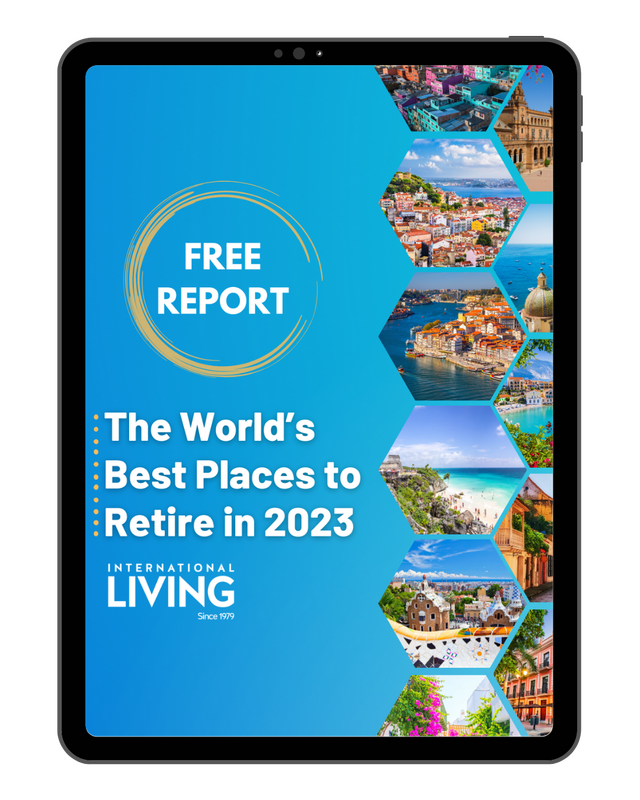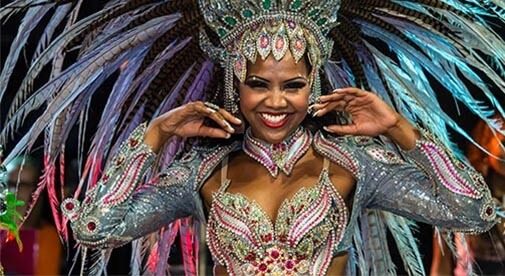As a last blast of fun, revelry, and feasting before the hardships of Lent, the celebration of Carnival (or Carnevale, as it’s known in much of the world) has grown over the centuries to become one of the planet’s biggest and most raucous nights out.
And although most of us think of Rio de Janeiro first, there are carnival celebrations elsewhere, too. They’re not all big-city affairs; many of the most interesting celebrations take place in small towns and villages, where folk traditions from a pre-industrial age weave their way into the proceedings. Smaller carnival events in Italy or Panama reward the adventurous traveler with an experience that is less glitzy, but with more local flavor.
Some are booze-fuelled riots of bacchanalian excess, others are important outlets for political dissonance, and a few are simply unfathomable examples of traditions that have survived millennia. Below, our writers guide you through their favorites.
Often Copied, Never Equaled: Brazil
Known for some of the most elaborate costumes, over-the-top floats, and incredible dancing you’ll ever experience, there is a reason that carnival in Brazil is celebrated for being one of the world’s best parties. Carnival marks the beginning of Catholic Lent, putting almost the entire country on pause for the national holiday while attracting people from all over the world.
Although carnival only officially takes place over five days (this year it’s from Feb. 21 to 26), festivities can be found on nearly every corner for the Smiles and sequins are everywhere in Rio de Janeiro during carnival, but it’s not the only option. Where to Enjoy Carnival Around the World By the Staff of International Living entire month. Daily street parties and accompanying caipirinha stands (a traditional Brazilian cocktail made with cachaça, a sugarcane liquor) help add to the sense of anticipation. You’ll often come across samba blocos (bands) with highly skilled drummers performing as they sway along. Groups of people usually dance behind each bloco, and it’s perfectly acceptable to join in.
Join in the free street parties all over the city.
Rio de Janeiro stages the world’s biggest carnival, with around 2 million people on the streets every day. At night you can join a street party or sit and enjoy the world-class parades in the Sambadrome stadium where diverse samba schools compete for the winning title. If you’re looking for more upscale revelry, take part in evening balls in the city’s finest hotels. Carnival has something to offer every type of traveler; you’ll see people of all demographics and nationalities joining together in tiny backstreets and larger venues alike. Book accommodation near the beach in Copacabana or Ipanema and get around by Uber or the efficient metro system.
For Carnival 2020, the Champions Parade will be on Saturday, Feb. 29. However, the most important main parades are Feb. 23 and 24, when six of the principal 12 samba schools perform. Both parades are similar in terms of format and quality. Tickets for the Sambadrome typically range from around $70 to $1,200, depending on the date and sector you choose.
Front-box tickets in sectors eight to 11 provide the best view and atmosphere, as most judges are located here. If you speak good Portuguese, or have Brazilian contacts, you can get cheaper tickets elsewhere. If not, there are several helpful websites, such as Rio-carnival.net/en/faq/tickets, to help you decide what is best based on your budget. It’s advisable buying well in advance as tickets get booked up quickly.
Rio is not the only place to celebrate carnival in Brazil, though. If you’re looking for something slightly off the tourist trail, try Salvador de Bahia, which has the strongest Afro-Brazilian heritage and is less commercial than other carnivals. In Salvador you can pay to join an abadá, a protected roped area around a trío eléctrico parade float (tickets cost between $56 and $445, depending on the artist) or buy entrance tickets to camarotes (closed venues offering drinks, food, and music with terraces overlooking the parade route. Tickets cost between $25 and $250 per day).
Alternatively, simply join in the free street parties happening all over the city. The main carnival circuits are Barra-Ondina (which follows the coastal road and is fairly commercial with multiple international artists) and Campo Grande (which also has big names performing but with more history and culture). Here you can also purchase arquibancadas—raised seating tickets, which cost between $8 and $17 per day.
The Pelourinho/Praça da Sé historic center is the least crowded circuit and is a good choice as it celebrates Salvador’s rich cultural heritage. It’s often the best place to see capoeira performances (a Brazilian martial art/dance). Book accommodation through Airbnb for an apartment over-looking one of the carnival circuits, then you get the best of both worlds. However, do bring earplugs, as carnival doesn’t finish until 4 a.m. each night. Carnival here can be economical after your airfare, accommodation, and food/drink, as nearly all the street parties, performances, and parades are free to watch.
The weather is also perfectly matched, with warm summer days for soaking up rays on Brazil’s multitude of stunning beaches and slightly cooler nights made for dancing to addictive samba beats. The energy that Brazilians possess is just phenomenal; the colors and sounds merge until the samba rhythms seem to seep into your very skin. Wherever and however you choose to celebrate, carnival in Brazil is not to be missed.—Emma Saville.
Panama’s Wet and Wild Carnavales
Bigger than Independence Day or New Year’s Eve, Panama’s number one holiday is carnival, often referred to as Los Carnavales. Though the exact dates change in accordance with the Catholic calendar, carnival always takes place during Panama’s gloriously sunny summer. (The five days before Ash Wednesday, which usually falls in February.)
Want to wear a yellow mesh onesie and head boppers?
Before this predominantly Catholic country settles in for 40 days of Lent— traditionally a time of sacrifice and “good” behavior—it’s customary to let loose. Bigwigs who spend the year in formal office attire don big wigs and short shorts. They drink and dance in the streets with people from all walks of life. Want to wear a yellow mesh onesie and purple head boppers? Great! The more outlandish your getup, the better.
Like I said, this is Panama’s number one holiday— Panamanians have been known to quit their jobs or camp out in their cars rather than miss out on the fun. So, needless to say, lodging in the most popular spots can be hard to come by unless you plan ahead. So, plan ahead.
Panama City puts on a big, expensive show with many popular music acts performing live on the Cinta Costera, or coastal belt. But the best-known fetes take place in El Interior—the provinces outside the modern capital. Number one on that list is Las Tablas, in the region known as the Cradle of Folklore.
Lavish parades include floats with fanciful themes—I’ve seen everything from fire-breathing dragons to Pre-Columbian art towering over the crowds. Carnival queens dance atop the floats for hours, wearing sparkling costumes and headdresses that can weigh as much as 50 pounds.
There are two queens, each with their own “court” representing Calle Arriba (uptown Las Tablas) and Calle Abajo, downtown. Brass bands known as murgas—immortalized by the song La Murga de Panamá—play loud, raucous music for everyone to dance to.
The parades are impressive…but there’s another component to the formula for madcap celebrations unlike any other in the world. Imagine dancing to loud music under a glaring tropical sun. Sound hot? It is—which is why cistern trucks use firehoses to continually spray water over the crowd. As the stream of water comes your way, you’ll see everyone jumping up and down, shouting “Agua, agua, ueeeee!” These mass dousings, known as culecos or la mojadera, are what take carnival in Panama over the top.
If you get tired of dancing in the sun, you can visit food carts selling simple fare like hamburgers, fried plantains, and carne en palito (grilled meat kebabs). But beware—just about anything goes during carnival, so outside the mojadera area there will be folks with water pistols and the like (even cans of whipped cream), aiming at anyone who looks too dry or clean. Even cars passing through town are fair game—if your windows are open, you’re liable to get a whole bucketful of water lobbed at you.
Penonomé, another town in the interior, holds a similarly popular carnival celebration. But there’s one big difference—the main parade is held not on the street but on the Zaratí River. The floats are smaller than the ones found in Las Tablas, and they’re pushed through the water not by motors or rowers but by locals who swim alongside them. The lush river setting and the culecos in the pretty little main plaza make Penonomé my favorite carnival spot.
So that’s Carnaval en Panamá for you—four days of constant drinking and dancing, with culecos, parades, fireworks, and yet more dancing at popup discotheques that go all night. If it sounds crazy, that’s because it is. But if you think it sounds like something only a college kid could enjoy, think again—people of all ages celebrate carnival here.
For the best carnival experience book early, always protect your skin from the sun, and if someone offers you shots of a local spirit called Seco Herrerano, practice your Spanish by saying No, gracias—that stuff is rocket fuel.—Jessica Ramesch.
Carnaval in Barranquilla, Colombia

Carnaval Barranquilla is an event that unites the sacred with the secular; the rural with the urban; the past with the present; and the wealthy with the poor. As the second-largest carnival in the world, it is a cultural event of such great importance that it has both the designation of Heritage of the Nation, granted by the National Congress of Colombia in 2001, and Oral and Intangible Heritage of Humanity, granted by UNESCO in 2003.
In a city where an average day is best described as cipotudo (a local slang word for exuberant), the carnival takes the mood of the city to an entirely different level. Barranquilla is Colombia’s fourth-largest city. Every year the residents join together with nearly 2 million visitors to celebrate the local traditions of cumbia music and dance. The Barranquilla Carnaval motto is ¡Quien lo vive, es quien lo goza!, which translates to “Those who live it are the ones who enjoy it!” This motto embodies the spirit of letting loose during carnival.
People around the entire metropolis get festive.
Although carnival technically runs from the four days leading up to Ash Wednesday, the city of Barranquilla celebrates for nearly an entire month. During carnival preparations, people around the entire metropolis get into festive mood with lots of drinking, dancing, singing, and costume wearing. Decorations adorn every mall, restaurant, street corner, and home.
Joel Duncan, a Canadian by birth and current resident of Medellín, Colombia, has been to Carnaval Barranquilla many times. “My experience with Carnaval has been nothing short of spectacular,” he says. “My first time was in 2012, and last year, 2019, made my seventh year in a row. The experience has gotten progressively better as time has passed.
“My biggest surprise was that it doesn’t matter if you are a doctor or somebody living on the street, everybody celebrates together. People are in such a festive mood, wanting to take photos of you, eat, drink, and dance with you. It’s like Colombia coming together for me. I never would have expected that from a Carnaval.”
Sydney Leah, from Laurel, New York, echoes that sentiment. “I loved that there was music everywhere, and there were happenings for every budget, from free events to lavish parties,” she says. “The biggest surprise for me was that, while it was super festive, it wasn’t out of control. I’ve never been to New Orleans or Brazil for Mardi Gras or carnival, but it sounds like things get crazy. In Baranquilla, it was fun but not too crazy.”
“What I found most interesting is that the Barranquilla Carnaval seems to have a more family vibe to it,” explains Jon Bullock. Jon, from Lilburn, Georgia, now lives in Barranquilla. “My experience was great. I’ve also been to carnival in Rio de Janeiro, which is much bigger and very different than the carnival in Barranquilla. I enjoyed seeing everyone wearing bright colors and the festive atmosphere in the air throughout the city.”
The best way to experience carnival is to go with a local. During his many trips, Joel has made several local Barranquilla friends. “In 2013, I got introduced to a woman my age and all of her family,” he explains. “That changed my experience entirely because I got a local perspective. Watching the parade is much more significant when you are watching it with local Colombian people. They explained the costumes, the significance of the songs, and knew where the afterparties were. You wouldn’t get that just being a backpacker or tourist.”
The origins of Barranquilla Carnaval date back to the late 1800s. Many of the traditions and celebrations stem from indigenous pagan celebrations held to welcome spring and celebrate fertility. What really sets Barranquilla’s carnival apart today is that it is a melting pot of cultural influences representing the diversity of Colombia’s Caribbean coast population.
Nothing personifies the culture of Barranquilla more than la cumbia. This dance is considered one of the most representative of the region. Cumbia began as a courtship dance practiced by the African populations along Colombia’s Caribbean coast. It evolved over time, mixing with European instruments, steps, and musical characteristics, and spread all over Colombia.
The Battle of Flowers (La Batalla de Flores) is the official kick-off event. It is one of the largest, most popular, and oldest parades of the carnival. This six-hour procession travels along Via 40 and is filled with elaborate and colorful floats, amazing costumes, folk dancing, fire breathers, and live music. The Barranquilla Carnaval Queen presides over the event, which draws almost 2 million people (including Colombia’s president). Seats in the grandstands sell out quickly, and you will find it virtually impossible to find a spot to watch the parade otherwise, so book ahead.
Joel learned this the hard way. “My first year, I didn’t have my hotels booked in advance, I didn’t know anyone in Barranquilla, and I didn’t have my pass for the grandstand. So my friends and I stood on the outside looking in,” he laments. “We couldn’t see anything that was going on in the parade or interact with the people. Some people on the streets were spraying us with foam and sprinkling the maicena (white corn powder) in our faces. While I knew this was part of the celebration, the novelty wore off quickly.”

The music and dancing are cornerstones of carnival. But it’s the costumes that truly embody the spirit of the festival. Marimonda is the only Carnaval character with origins in Barranquilla. The masked character has a long nose and big ears, and looks a lot like a monkey crossed with an elephant. He is dressed in bright, mismatched colors. Originally, the marimonda character was created by a poor man to poke fun at high society. With very few resources he borrowed large pants from his brother and pieced together a comical suit with two neckties—one in the front and one in the back. Today the marimonda represents the humorous and irreverent spirit of the people of Barranquilla.
If you are planning to attend, dress up.
Everywhere you look you will see thousands of colorful costumes and people covered in body paint. Women in full outrageous makeup wear bright neon headdresses made from feathers, rhinestones, and fruit. So, if you are planning to attend carnival, dress up. There are no rules. Anything and everything goes, the crazier the better. Truly, you will feel more out of place if you don’t dress up than if you do.
Carnaval Barranquilla is a photographer’s dream. It inspired Joel to begin his coffee table book project—10 Years of Carnaval Photography. “You can see how the people in my group and the people in the event have aged and changed over the years,” he says. But change and age are the stuff of everyday life. Put them away for a time and enjoy carnival—the pure antithesis of the everyday.—Nancy Kiernan.
It’s Not Just the Americas: Carnevale Traditions in Italy
While it’s Venice that gets all the attention for its Carnevale celebrations, the rest of Italy is no slouch either when it comes to the long-running business of festive pre-Lenten merriment. From small towns to large cities, the traditions around Carnevale vary all over the country. Finding a room in Venice during the festivities can be a tall order, and if you manage it, you’ll be paying a premium. In other parts of Italy, though, celebrations are raucous and convivial but much more easily accessed.
What can you expect? In Ascoli Piceno, they have a fantastic Carnevale with groups and individuals putting on skits that poke fun at the politics, faux pas, and civic scandals that have gone on the previous year. Or, in Basilicata, there are some interesting anthropomorphic traditions tied to Carnevale, including one where men dress to represent cattle and dance with big cow bells (it’s cooler than it sounds), one that involves a “walking forest,” and yet another that celebrates a “marriage” of two towns (in cross-dress) officiated on the church steps. It’s the continuation of a tradition to end a feud.
Another one that I loved, in Le Marche, is the running of a fake bull—a sort of corrida—in which townspeople are chased by something a little like a pantomime pony, but with large horns to menace its victims. (The fake bull doesn’t actually poke people, just chases them around while they swig wine. The stains on their traditional white shirts end up looking like they’ve been gored). And in the same region, there’s another event called i muccoli where townspeople parade with cane lanterns that all end up thrown into a big bonfire at the top of town. Folks (usually young drunk guys) proceed to amp up the atmosphere by jumping over the fire.—Valerie Fortney-Schneider.

Get Your Free Report on the World’s Best Places to Retire:
Learn more about the best places in the world to retire in our daily postcard e-letter.
Simply enter your email address below to sign up for our free daily postcards and we’ll also send you a FREE report on The World’s Top 10 Retirement Havens, plus access to over 10 more free reports. Our gift to you, on our favorite destinations.
Related Articles
5 Best Cities to Visit in Brazil
The 3 Questions I’m Always Asked About Panama
3 Towns I Love Near Medellín, Colombia & Guatapé, Jericó, and Jardín
Upcoming Conferences
Most Popular Products
Panama 101
Portugal 101
Costa Rica 101




